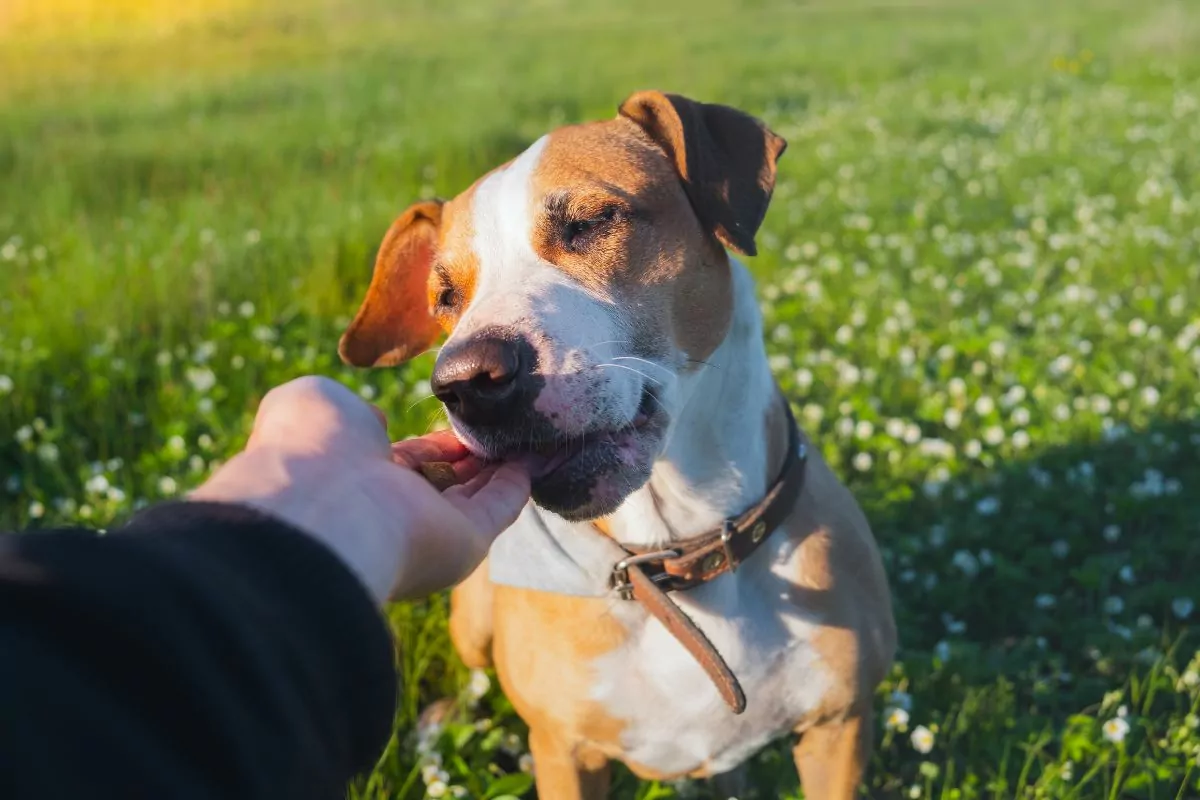Making Dog Treats At Home
Dogs are not just pets; they are cherished members of our families. Giving them dog treats with bananas can be a great way to show love and care. While store-bought treats offer convenience, crafting treats at home gives you control over the ingredients, ensuring a healthier and tastier option.
In this article, we’ll explore the world of homemade dog treats, focusing on two delightful recipes featuring a favorite fruit – bananas. Let’s find out more.

Easy Banana Dog Treat Recipes
Bananas are a powerhouse of nutrients for dogs. Rich in potassium, vitamins, and fiber, it contributes to a healthy diet and supports your dog’s well-being.
Beyond their delicious taste, bananas boost the immune system, aid digestion, and provide a natural energy source. Including this fruit in your dog’s treats can be tasty and nutritious.
Here are three simple dog treats with oats, peanut butter and banana:
Peanut Butter, Banana and Honey Dog Treats
Time: 25 minutes
Serving size: 30 servings
Prep time: 10 minutes
Cook time: 15 minutes
Equipment Needed
- Mixing bowl
- Baking sheet
- Cookie cutters
- Parchment paper
- Rolling pin
Ingredients
- ½ cup natural peanut butter
- 1 ripe banana, mashed
- 2 tablespoons honey
- 1 egg
- 2 cups oat flour
Directions
- Set the oven: Preheat your oven to 350° Fahrenheit (180° Celsius). Put in a baking sheet aligned with parchment paper.
- Combine wet ingredients: In a mixing bowl, blend the natural peanut butter, mashed banana, honey, and egg. Mix until the ingredients are well blended.
- Add oat flour: Gradually add the flour to the wet mixture, stirring continuously until a dough forms. Ensure the flour is fully incorporated.
- Roll out the dough: Spread the dough to your desired thickness using a rolling pin on a floured surface. Use cookie cutters to cut out shapes or create bite-sized treats.
- Place on baking sheet: Arrange the cut-out treats on the baking sheet, spreading them out with enough space between each treat, about half an inch (1.27 centimeters).
- Bake: Bake them for about 10 to 15 minutes or until the treats turn golden brown around the edges.
- Cool completely: Let the treats cool completely before serving or storing.
3-Ingredient Peanut Butter Dog Treat Recipe
Time: 25 minutes
Yield: 40 to 50 small treats
Prep time: 10 minutes
Cook time: 15 minutes
Equipment Needed
- Baking sheet
- Mixing bowl
- Cookie cutters
- Rolling pin
- Potato masher
- Parchment paper
Ingredients
- 2 cups oatmeal or oat flour
- ½ cup natural peanut butter
- ½ cooked sweet potato
Directions
- Prepare the oven: Preheat your oven to 350° Fahrenheit (180° Celsius). Place a baking sheet with parchment paper.
- Prepare sweet potatoes: Cook the sweet potatoes until soft. Mash them thoroughly, ensuring a smooth consistency.
- Combine Ingredients: Combine the mashed sweet potatoes, peanut butter, and oat flour or oatmeal in a mixing bowl. Mix until a dough forms.
- Roll and cut shapes: Roll out the dough to your desired thickness on a floured surface. Use cookie cutters to cut out shapes or create bite-sized treats.
- Place on baking sheet: Arrange the cut-out treats on the baking sheet, leaving space between each.
- Bake: Bake them for about 12 to 15 minutes or until the treats turn golden brown around the edges.
- Cool completely: Let the treats cool before serving them to your pup.
Ingredient Benefits
Peanut butter, sweet potato, and oatmeal dog treats are a delightful and nutritious way to pamper your pup. These three-ingredient dog treats have the following benefits:
Peanut Butter
Peanut butter is a canine favorite, providing protein, healthy fats, and essential vitamins. Choose natural peanut butter without xylitol or added sugars.
Sweet Potatoes
Sweet potatoes are nutrient-rich, offering vitamins, minerals, and dietary fiber. They contribute to a well-rounded and healthy canine diet.
Oat Flour or Oatmeal
Oat flour is a gluten-free alternative to traditional flour, providing a source of fiber and essential nutrients. It’s gentle on your dog’s digestive system.
The beauty of three-ingredient dog treats lies in their simplicity. Busy pet owners can rejoice as these recipes require little time and effort in the kitchen. Keeping the ingredient list short allows for a focus on wholesome components, ensuring that each element contributes to your dog’s well-being.
No-Bake Dog Treats With Banana
Creating tasty treats for your furry friend doesn’t have to be a complicated task. With easily accessible ingredients and minimal effort, you can provide your pets with homemade treats without baking. Here is how to:
No-Bake Peanut Butter, Banana, and Honey Dog Treat Recipe
Time: 2 hours 10 minutes
Yield: 30 to 40 small treats
Prep time: 10 minutes
Cook time: 2 hours
Equipment Needed
- Mixing bowl
- Potato masher
- Hand mixer
- Cookie cutter
Ingredients
- 2 ripe bananas
- 2 cups oatmeal or oat flour
- ½ cup natural peanut butter
- 8.4 fluid ounces (250 milliliters) Greek yogurt
- Honey (optional)
Directions
- Gather your ingredients: Assemble all the ingredients, ensuring you have ripe bananas, freshly rolled oats, natural peanut butter, Greek yogurt, and optional honey.
- Mash the bananas: Mash the ripe bananas in a mixing bowl until they become smooth. This serves as the base for your no-bake treats.
- Add oats and peanut butter: Add the peanut butter and rolled oats to the mashed bananas. Stir well to create a cohesive mixture.
- Shape into treats: With the mixture ready, shape it into small bite-sized treats. You can use your hands or a cookie cutter for added charm.
- Refrigerate: Place the treats on a tray and refrigerate until they firm up. This usually takes about one to two hours.
- Drizzle with yogurt and honey: Once firm, you can enhance the treats by drizzling a bit of Greek yogurt and honey. This step adds a touch of indulgence.

FAQs About Dog Treat Recipes
Are Homemade Dog Treats Safe for Dogs?
Yes, homemade dog treats are safe for dogs if made with canine-friendly ingredients. However, it’s essential to be mindful of certain factors to ensure the treats are both nutritious and safe:
Ingredients
Use dog-friendly ingredients and avoid known toxic substances for dogs. Some ingredients commonly found in human recipes may not be suitable for dogs. For example, excessive salt and sugar, chocolate, onions, garlic, and nuts can be harmful. Always research the ingredients to make sure they are safe.
Allergies
Be aware of any allergies your dog may have. Common allergens for dogs include wheat, soy, and dairy. If your dog has known allergies, choose ingredients that won’t trigger a reaction. Also, avoid using ingredients like baking powder or baking soda, as they may cause allergic reactions in dogs if used in large quantities.
Consult Your Vet
Before introducing new treats into your dog’s diet, it’s a good idea to consult with your veterinarian. They can give guidance based on your dog’s specific health needs and dietary requirements.
Small Portions
Start with small quantities to see how your dog reacts when introducing new treats. Monitor for any signs of digestive issues or allergies.
Proper Storage
Proper storage is crucial to prevent spoilage and bacterial contamination like human food. If your homemade treats contain perishable ingredients, store them in the refrigerator.
How Do I Store Dog Treats Made at Home?
Here are some general guidelines for storing homemade dog treats:
Cool and Dry Storage
Store your dog treats in a cool and dry place. Avoid areas with high humidity, as moisture can lead to mold growth. Airtight containers or treat jars are excellent choices to keep treats fresh.
Refrigeration
If your homemade treats contain perishable ingredients, such as meat, cheese, or yogurt, storing them in the refrigerator is advisable. This aids in preventing bacterial growth and keeps the treats from spoiling.
Freezing
If you’ve made a large batch of treats or want to extend their shelf life, consider freezing them. Put the treats in a freezer-safe container or bag, ensuring they are well-sealed to prevent freezer burn. Thaw frozen treats in the refrigerator before serving.
Avoid Direct Sunlight
Exposure to direct sunlight can cause treats to degrade and lose their quality. Keep treats in a dark or opaque container to protect them from light.
Separate Treats
If you make dog treats with different textures or moisture levels, consider storing them separately. This helps prevent moisture transfer and maintains the integrity of each treat.
Use Treats Within a Reasonable Timeframe
While homemade treats may lack the preservatives in some commercial options, they typically have a shorter shelf life. Be mindful of the expiration dates, and use the treats within a reasonable timeframe to ensure they are fresh and safe for your dog to consume.
Can You Substitute Ingredients in Dog Treat Recipes?
You can often substitute ingredients in dog treat recipes, but ensuring they are safe and suitable for canine consumption is crucial. Here are some general guidelines for ingredient substitutions in dog treat recipes:
Research Dog-Safe Substitutes
Before substituting, research to ensure the replacement ingredients are safe for dogs. Some human foods, even though safe for us, might harm dogs.
Consider Allergies
If your dog has known allergies, be mindful of ingredient substitutions. For example, if a recipe calls for wheat flour and your dog is allergic to wheat, you might substitute it with dog-friendly flour like rice flour or coconut flour.
Adjust Portion Sizes
Some ingredients may have different moisture levels or nutritional content than others. When substituting, consider adjusting the portion sizes to maintain the overall balance of the recipe.
Avoid Harmful Ingredients
Certain human foods are known to be harmful to dogs. Common examples include chocolate, onions, garlic, raisins, and nuts. Ensure that your substitutions don’t introduce any toxic elements.
Maintain Nutritional Balance
If you’re substituting key ingredients that contribute to the nutritional content of the treats, make sure the replacements still provide a balanced and nutritious snack for your dog.
Texture and Consistency
Consider the consistency and texture of the ingredients you’re substituting. For example, if a recipe calls for peanut butter, replacing it with a different nut butter may work, but consider potential differences in texture and flavor.
Check for All-Purpose Dog Treat Recipes
If you need clarification on ingredient substitutions, look for versatile dog treat recipes with limited ingredients that benefit your dog. Some recipes may already provide a range of options or alternatives.
Can Homemade Dog Treats Be Frozen?
Yes! Freezing is a practical solution to extend the shelf life of your homemade dog treats and ensures your pup continues to enjoy fresh, tasty treats. You can treat your dog to homemade goodness any time of the year with proper storage and thawing techniques.
Generally, you can keep them frozen for up to three months. Beyond that, they may lose quality.
Here are easy steps to freeze your homemade dog treats:
- Cool completely: Before freezing, allow the treats to cool completely. Hot or warm treats can lead to ice crystals, affecting the texture.
- Use airtight containers: Place treats in airtight containers or resealable freezer bags. Removing excess air helps prevent freezer burn and maintains freshness.
- Label and date: To keep track of storage times, label the containers with the treat type and date of preparation. Use older treats first to ensure they remain at their best.
How Many Treats Can a Dog Have Per Day?
It would be best to view dog treats as nutritional supplements rather than primary food. They can contribute to your dog’s overall diet but should not replace balanced meals.
Generally, they should not make up more than 10% of your pet’s daily calories. For instance, if you have a medium dog that consumes 500 calories daily, and the treats you provide them are 25 calories, you can give them two daily (Fields, 2022).
It is best to follow the recommended guidelines for your dog’s size and adjust based on their individual needs. Also, consult your veterinarian to determine an appropriate treat allowance considering your dog’s health condition.
Are Homemade Canine Snacks Healthier Than Store-Bought Ones?
The debate between homemade and store-bought canine treats ultimately hinges on your priorities as a pet owner. The answer lies in carefully considering ingredients, your dog’s unique needs, and the balance between convenience and health.
Homemade treats have the upper hand when it comes to nutritional value. You can choose fresh, high-quality ingredients, ensuring your dog receives the essential nutrients they need.
Why Choose Homemade Over Commercial?
Ingredient Comparison
Comparing the ingredients in commercial treats with homemade ones reveals the stark difference. Homemade treats allow you to exclude additives and choose high-quality, fresh ingredients.
Cost-Effectiveness and Environmental Impact
Making treats at home is often more cost-effective and reduces the environmental impact of excessive packaging associated with store-bought treats.
Can I Use Instant Oats Instead of Rolled Oats?
Yes, you can use instant oats as a substitute for rolled oats in your three-ingredient dog treats. While rolled oats provide a better texture, instant oats are a suitable alternative, especially if that’s what you have available in your pantry.
The key is to ensure that the consistency of the mixture is appropriate for shaping into treats. Feel free to proceed with instant oats for a convenient and equally delightful homemade treat for your furry friend.
Common Mistakes to Avoid
Making homemade dog treats can be a rewarding experience, but it comes with its share of challenges. To ensure that your furry friend gets the best, you must be aware of common mistakes pet owners often make.
Here are some common mistakes and how to avoid them:
1. Ignoring Portion Sizes
Mistake: Overlooking portion sizes, leading to overfeeding and potential weight issues.
Solution: Be mindful of your dog’s size and dietary needs. Adjust treat sizes accordingly, considering their overall daily caloric intake to maintain a healthy weight.
2. Neglecting Ingredients (Check for Allergies)
Mistake: Not checking for potential allergies your dog may have to specific ingredients.
Solution: Before introducing new ingredients, consult your vet to ensure they are safe for your dog. Monitor your pet for any adverse reactions after trying a new treat.
3. Skipping Texture Considerations
Mistake: Not considering the texture of the treats, which may pose a choking hazard.
Solution: Choose ingredients that are easy to chew and swallow. Cut treats into appropriate sizes, especially for smaller dogs or those with dental issues.
4. Neglecting Temperature Control
Mistake: Not allowing treats to cool properly before serving, leading to burnt mouths.
Solution: Patience is key. Ensure treats are completely cooled before offering them to your dog to prevent any potential burns.
5. Overcomplicating Recipes
Mistake: Choosing overly complicated recipes that may lead to frustration and mistakes.
Solution: Start with simple recipes and gradually experiment with more complex ones as you gain confidence. Keeping it simple ensures a higher chance of success.

Final Reflections
Homemade dog treats with peanut butter and bananas offer your canine companions a tasty and nutritious option. With the benefits of controlling ingredients and customization, these treats are a win-win for pet owners and furry friends.
Investing a little time crafting treats allows you to express your love and contribute to your dog’s well-being. Try these easy dog treats with bananas, and witness the delight they bring to your dog’s day!
References
Fields, L. (2022, August 11). The right way to treat your pet. WebMD. https://www.webmd.com/pets/pet-treats
